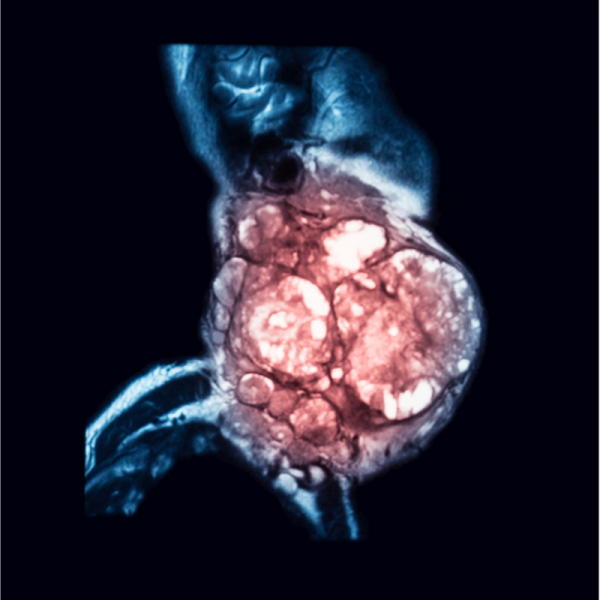
What is nasopharyngeal carcinoma?
Nasopharyngeal carcinoma is a type of cancer of the nasopharynx and usually occurs as squamous cell carcinoma. Nasopharyngeal carcinoma is one of the most common malignant cancers of the pharynx. The tumour disease manifests itself by a unilateral bloody nasal discharge, but can also cause hearing loss, ear pain and/or facial swelling with a feeling of numbness. Nasopharyngeal carcinoma is diagnosed by biopsy. Imaging can assess the extent of the disease. In most cases, nasopharyngeal carcinoma is treated with radiotherapy and/or chemotherapy; in more rare cases, the tumour may be operated on.
What is the nasopharynx?
The nasopharynx is also called the upper aerodigestive tract and includes the nose, mouth and throat area. The nasopharynx is where the inside of the nose, called the nasal cavity, meets the throat. Because the nasopharynx is covered by cells called squamous cells, nasopharyngeal carcinoma usually occurs as squamous cell carcinoma. The so-called squamous cells form the epithelium, a barrier on the surface of the nasopharynx.
Incidence of nasopharyngeal carcinoma
Nasopharyngeal carcinoma can develop in any age group and is particularly common in the South China Sea region. Within the USA and Western Europe, nasopharyngeal carcinoma is one of the most common cancers among Chinese immigrants. Groups of people with South Chinese and Southeast Asian ancestry are particularly often affected.
In addition to ancestry, the intake of above-average amounts of nitrites and the frequent consumption of salted fish are also suspected of increasing the risk of nasopharyngeal carcinoma. However, the Epstein-Barr virus (EBV), a corresponding hereditary predisposition and environmental influences also significantly increase the risk of tumour formation.
What are the symptoms of nasopharyngeal carcinoma?
Nasopharyngeal carcinoma is usually manifested by palpable lymph node metastases in the throat and impaired nasal breathing. However, hearing loss can also occur due to the impairment of the nose, or the eustachian tube, and can lead to a middle ear effusion. As a result, the patient may complain of earache, a bloody-sided rhinorrhoea and/or nosebleeds (epistaxis).
If the tumour spreads, the bulb of the eye may protrude from the eye socket (exophthalmos), double vision may develop and visual and/or olfactory disorders may occur. If the tumour has penetrated to the base of the skull, it can also lead to cranial nerve paralysis, resulting in severe, therapy-resistant headaches.
How is nasopharyngeal carcinoma diagnosed?
If a nasopharyngeal carcinoma is suspected, the doctor will first examine the mouth breathing, the throat lymphomas and perform a mirror examination and/or endoscopic examination of the nasopharynx. During these examinations, a tissue sample of the existing lesions is taken and then a biopsy is performed. The biopsy can be used to determine with certainty whether the cancer is malignant.
Since the base of the skull is also involved in about 25 per cent of patients, a CT should also be performed to check the function of the cranial nerves and to determine to what extent the tumour has already spread. A CT scan reveals bony changes in the base of the skull. Furthermore, a PET scan can reveal the extent of the tumour as well as the cervical lymphatic vessels, which is essential for classifying the individual cancer stages of head and neck tumours.
Since nasopharyngeal carcinoma usually develops inconspicuously and causes hardly any discomfort, the tumour is usually already far advanced when it is diagnosed.
How is nasopharyngeal carcinoma treated?
Nasopharyngeal carcinoma can be removed by surgery or treated with chemotherapy and radiation. However, surgical intervention is usually extremely difficult due to the localisation of the tumour and can only be used for smaller tumours. Therefore, nasopharyngeal carcinoma is usually treated with chemotherapy and radiotherapy and is mainly used to reduce the size of the tumour. If there is also a suspicion of neck lymph node metastases, a so-called neck dissection is carried out. This is a surgical procedure in which all malignant neck lymph nodes are removed.
If the tumour reappears after successful treatment, the so-called recurrent tumour is treated with further radiotherapy. Alternatively, a skull base resection can be used. In this case, part of the upper jaw may have to be removed to create access. In some cases, however, the resection can also be done endoscopically.
What is the prognosis for nasopharyngeal carcinoma?
If the carcinoma is diagnosed and treated at an early stage, the 5-year survival rate is between 60 and 75 per cent. If, on the other hand, the carcinoma is discovered in stage IV and treatment is initiated, the 5-year survival rate is reduced to less than 40 percent. Even after the successful treatment of a nasopharyngeal carcinoma, regular check-ups are important in order to detect any new tumour formation early and to treat it accordingly.
